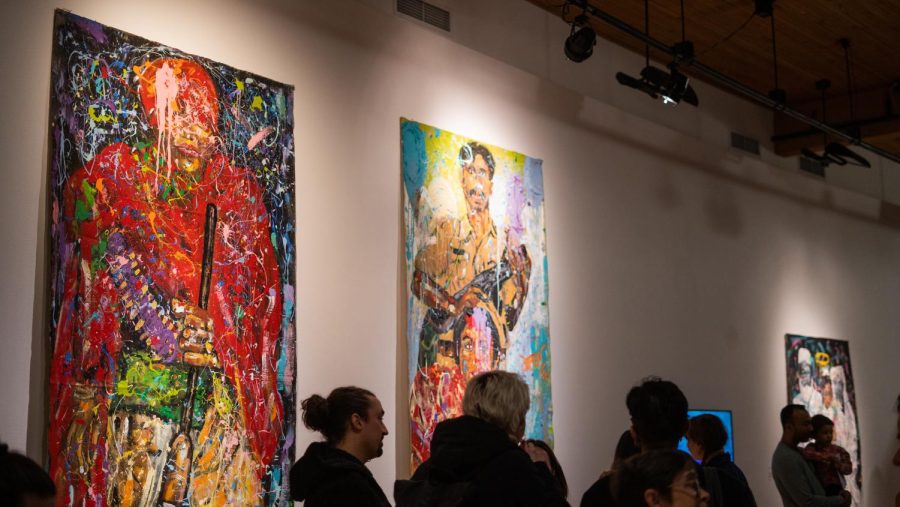Hedreen Gallery Exhibit Opening: Rohena Alam Khan’s Daughter of a Revolution
On the gallery’s opening night, Jan. 26, the artist walks around the small open space with anklets of bells that ring with every barefooted step. Usually, an event like this has a hushed mood, with the art on the walls doing all the talking and the rest of the room in whispers. However, tonight Rohena Alam Khan inspired a spirit of rebellion. From the speakers, Ice Spice’s “In Ha Mood” plays loud bass over the gallery’s speakers as the crowd of family, friends and members of the art and Seattle University community chat with each other before the artist’s Bharatanatyam dance performance.
Arielle Simmons, Hedreen gallery curator, was excited that the exhibition opened with a dance presentation.
“I believe the more the interdisciplinary the work, the more opportunities we each have to connect from our various perspectives, and it’s something I’ve been seeking in with every exhibit,” Simmons said.
As Alam Khan walked to the center of the room, thousands of eyes peeked over shoulders and through Zoom calls to get a view as the artist closed her eyes and carefully stepped into her place and her body.
As the child of freedom fighters in Bangladesh’s Liberation War in 1971, Alam Khan creates art that comes from both the violence and the strength of her heritage. “Daughter of A Revolution” exhibits five large canvas paintings and one short documentary that pay homage to her own experience as a revolutionary, as well as those of her family and her predecessors of the past. Representing herself as an independent person created by the experiences of those before her, her art speaks to the generational healing of Bangladeshi Muslim people, especially women, around and before her. Art is an avenue for people to tap into themselves and their emotions, and the same is for Alam Khan.
“It’s a way for me to process my feelings, but also, at the same time, tell very important stories and be able to express myself and talk,” Alam Khan said.
One of Alam Khan’s inspirations and main figures in this exhibit, Phoolan Devi, has her own portrait titled the “Bandit Queen.” Devi was a famous Hindu woman known as a Robin Hood-esque figure in the ‘90s as the leader of a bandit gang. She lived in the ravines and gorges of the Jalaun district in India, stealing from the higher castes and taking revenge on those who wronged her and her family. Alam Khan honors the rebellion against the violence and cruelty of patriarchy in her portrait of Devi, depicting her on a larger-than-life scale in a fashion normally reserved for war generals, or military personnel—but always for men. Holding a rifle and a staff, Phoolan Devi in “Bandit Queen” sits center frame with long red robes, exuding vengeful power yet still faceless with splatters of neon pink acrylic paint over her face.
The sheer scale of the art awed Miha Sarani, a visiting visual arts and art history professor.
“As a painter? I love the scale. I love the materiality. The colors. The way it was presented. Like, you know, just tacked to the wall. I like the stretcher bars. I think aesthetically it really, really resonated,” Sarani said.
While honoring the bravery of those before her, it was also important to Alam Khan that this gallery is part of a university where her art gets to be displayed in an environment that values knowledge and looking at the past while being a part of a better future.
“Because it’s on a college campus, it resonates with me as someone who, once as a college student, looked up to the artists who were exhibiting on campus. And I really like that because I feel like much of my work is educational. It’s about the world, it’s about the Indian subcontinent, like a lot of historical stuff. I like that angle,” Alam Khan said.
Though the historical influences are center stage in most pieces, there is also a consistent reminder of modernity and timeliness in her work. Combining traditional painting colors and techniques with loud, almost technology-reminiscent colors and paint messily thrown on, Alam Khan is able to create very distinctive work.
“When you’re starting to look at this bright neon clashing, they feel like they have a sense of artificiality to it. Which combined with figurative work, it creates this juxtaposition that I think is really fantastic,” Sarani said.
This exhibit is open for viewing until April 13, with regular gallery hours of Wednesday to Sunday, 1-6 p.m. at the Hedreen Gallery on campus.



Sean Wetmore
Apr 20, 2023 at 10:14 am
Wish I had been there, but thanks for the excellent article. Your writing is exquisite! We miss you at NA.
SPW